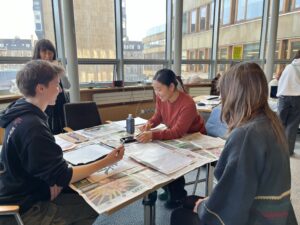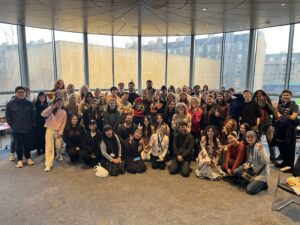ブログが書いた人:ビアンカ (Bianca Bersani)、ルーカス (Lucas Scroop)
学園祭は学生たちが色々な活動のために売店を設けた三月の午後に起こりました。だいたい、売店では手作りのお菓子とか食べ物が売られたり、楽しかったミニゲームが提供させたりしました。例えば、一つの売店では学生が速く多くの漢字を覚えなければなりました。さらに、とても面白かった売店が人々に書道を教えてあげました。

私達のグループは活動とお菓子を設けりました。確かに、一番目のグループの半分が有名だった抹茶のビスケットとパフとライスからできた食べ物を作って、二番目の半分が鶴や蛙など折り紙の作り方と意味を調査しました。私達が人々にその折り紙を教えて、人々が私が知らなかった折り紙を見せました。最後に、この体験は絶対に面白くて、友達と楽しみながら日本についていい習い方でした。(ビアンカ)

日本留学生と面接してから、日本の学園祭とエジンバラの学園祭は似ることと違いのこともあるそうです。まず、面接から、日本の大学で学生は自分で学園祭店をしていて、たいてい、そんな学園祭店は文化とか、料理とか、サークルのようなことについてを学びました。エジンバラの学園祭はそんなことをよくできました。でも、日本留学生が言ってくれた学園祭の経験の反対に、エジンバラの学園祭は演奏などがなくて、会場は外側ではなくて、内側でした。その理由は学園祭の大きさとエジンバラの二月の天気でも、残念でした。けれども、将来学園祭は本当に人気があったら、夏の学園祭をして、色々な新しい学園祭店があったらいいです。(ルーカス)

English version:
The Gakuensai took place during one afternoon of March, during which the students set up their stalls with various activities. Mainly, the stalls sold food such as home-made sweets, or offered some minigames. For example, one stall challenged students to recognize a set of kanji as fast as possible. Additionally, there was a very interesting stall that taught calligraphy. Our stall had both some sweets and an activity: some members of our group had baked matcha cookies and rice sweets that were very popular, while others had researched the instructions and meanings of some origamis, such as the crane and the jumping frog. We taught people how to make them, while they showed us new origamis that we didn’t know. Overall, the experience was very interesting and fun, and it revealed to be a good way to learn something new about Japan while having fun with friends. (Bianca)
From interviewing Japanese exchange students, it seems that there are some similarities and differences between Edinburgh’s Gakuensai festival and the Gakuensai festivals in Japan. First, from the interviews, I learnt that at Japanese universities the Gakuensai stalls are run by the students themselves and that usually these stalls are about things like culture, cuisine or the university’s clubs. It was these features that the Gakuensai at Edinburgh was able to replicate. However, in contrast to the Gakuensai experiences that the Japanese exchange students shared with me, there was no musical performances or the like at the Edinburgh Gakuensai and the festival was held indoors rather than the usual outdoors. Even though the reasons for this is the size of Edinburgh’s Gakuensai and the weather in Edinburgh in February, it is unfortunate. However, if the popularity of the Gakuensai in Edinburgh grows, hopefully there can be a summer festival with various new stalls. (Lucas)


Leave a Reply